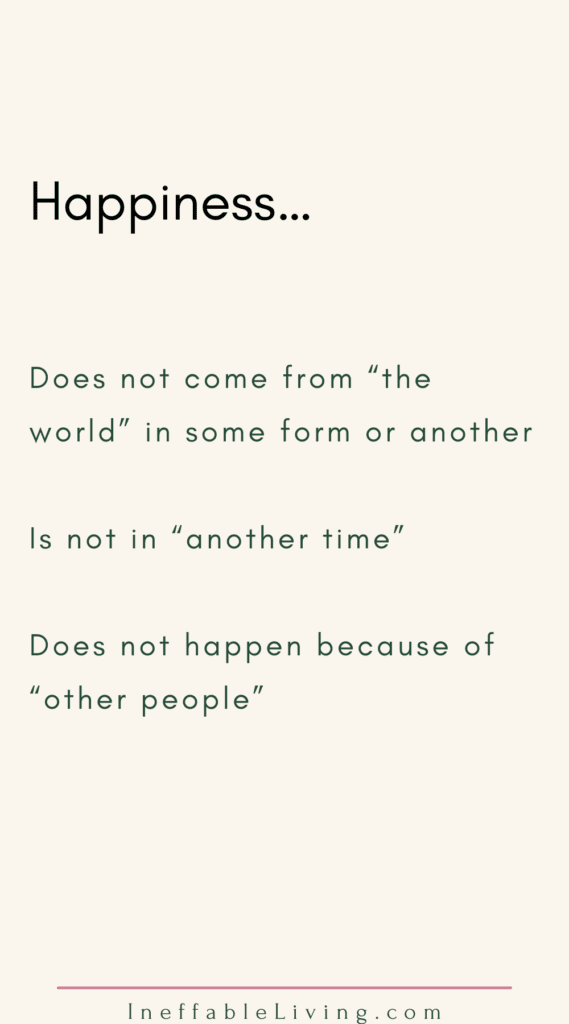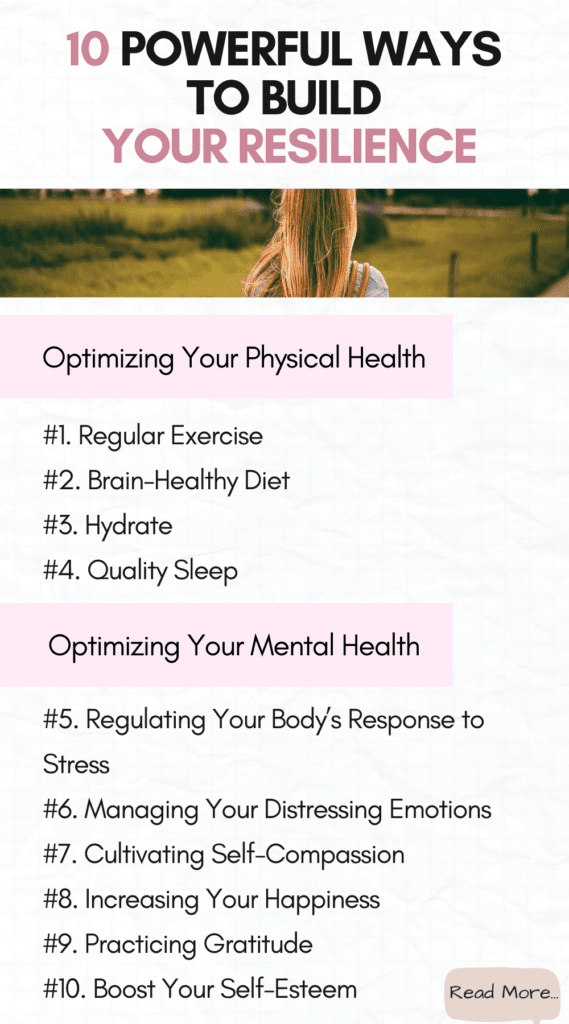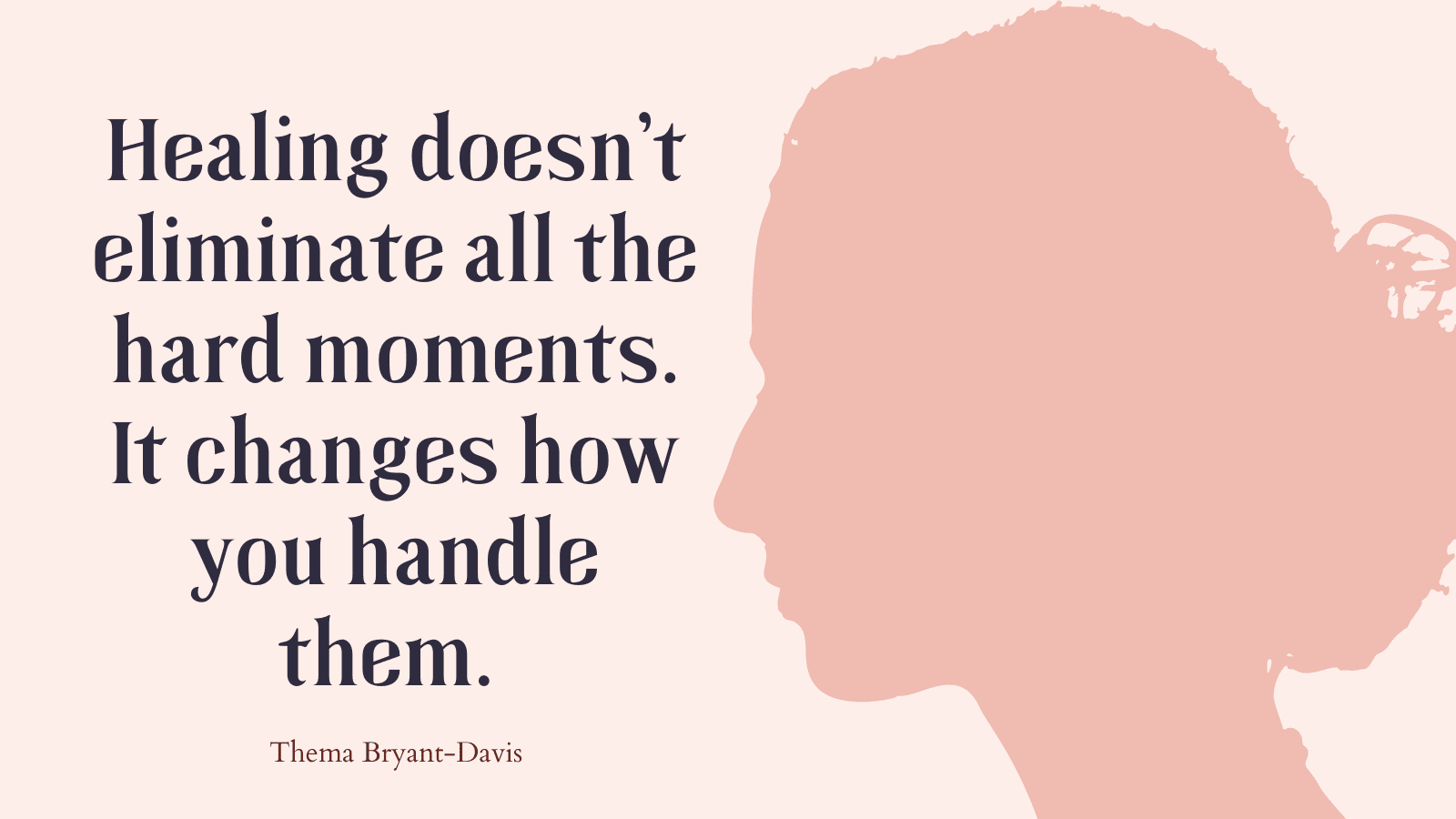Today, you’re going to discover the 5 pillars of resilience and how to build resilience.
Meaning of Emotional Resilience
Emotional resilience involves inner strengths of mind and character—both inborn and developed—that enable us to respond to adversity more effectively and recover faster from and prevent stress-related conditions, such as depression or anxiety.
Responding to adversity more effectively refers to having the ability to adapt calmly to changing circumstances, using the support of our resources – both internal (e.g., inner strengths) and external (e.g., support system).
Emotional resilience is a skill that can be expended through practice.
Why is it important to build emotional resilience?
Emotional resilience is the key to dealing with stress, rebounding from it, and performing at your best.
Some of us find it easier to develop emotional resilience more than others, and there are factors that can influence your emotional resilience such as genetics, certain personality traits, going through hard experiences… but there’s always room for improvement. (*)
Related: Resiliency Quiz: Am I Resilient?
5 Pillars of Resilience
There are five pillars of resilience: self-awareness, mindfulness, self-care, positive relationships, and purpose.
1. Self-awareness involves understanding your strengths, weaknesses, emotions, and reactions to stress.
2. Mindfulness means being present in the moment, non-judgmental, and aware of your thoughts and feelings.
3. Self-care involves taking care of yourself physically, emotionally, and mentally.
4. Positive relationships involve having a supportive network of people who provide encouragement, empathy, and understanding.
5. Having a sense of purpose gives you direction, motivation, and helps you overcome obstacles.
For example, a person may use self-awareness to recognize when they feel overwhelmed and need to take a break.
They can then practice mindfulness by taking a few deep breaths and focusing on the present moment.
They can also practice self-care by engaging in activities that help them relax and recharge, such as exercise or meditation.
Positive relationships can provide emotional support during challenging times, while a sense of purpose can help them stay focused and motivated.
Related: Top 15 Resilience Journal Prompts
5 Myths About Resilience
1. Being resilient is about acting tough.
You don’t have to appear tough to be emotionally resilient. Mental strength is more about acting according to your values.
2. Resilience requires you to ignore your emotions.
You don’t need to suppress your feelings to appear emotionally resilient.
It’s rather about becoming more aware of your emotions and understanding how your emotions can influence your thoughts and behavior.
3. Resilience is about ignoring your pain.
You don’t have to push yourself physically or emotionally to the limits to look resilient.
You need to understand your feelings and thoughts and determine when to act accordingly and when to act contrary to them.
4. Resilience requires you to be self-reliant.
Being emotionally isn’t about proclaiming that you don’t need help from anyone. It’s more about being able to ask for help when you need it and admit that you don’t have all the answers.
5. Resilience is about chasing happiness.
Emotional resilience helps you to be more content in life in general.
However, it isn’t about forcing yourself to be happy and suppressing any sad feelings you need to feel.
Related: Top 13 Toxic Habits Everyone Should Quit To Build Emotional Resilience
How To Develop Emotional Resilience?
Optimizing Your Physical Health
Emotional resilience starts with the physical conditioning of the brain, which refers to the size, health, and functioning of nerve cells and supportive tissues.
Optimizing the physical conditioning of the brain will help:
- Reduce inflammation and oxidative stress, which impair the brain
- Clear out harmful proteins that are found with Alzheimer’s disease
- Improve mood
- Enhance cognitive function (concentration, memory, creativity, speed of thinking, etc.)
#1. Regular Exercise
Many studies document the ways exercise can benefit mood and brain function.
Exercise enhances the production of master molecules in the brain that normally decreases with stress and aging.
These master molecules increase blood flow to the brain and help strengthen and grow neurons.
Exercise also helps reduce tension, anxiety, and depression, while improving sleep and increasing energy. It has been found to even reduce PTSD symptoms.
Exercise should be incorporated gradually. A reasonable goal is at least 150 minutes of moderate exercise a week. This might mean brisk walking, cycling, swimming, or slow jogging thirty minutes a day, five or more days per week.
Outdoor exercise can boost benefits by getting a few minutes of sunlight that raises vitamin D levels.
#2. Brain-Healthy Diet
A growing number of studies have shown Mediterranean-style diet to be the best diet to promote longevity and brain health.
This type of diet emphasizes fruits, vegetables, beans and peas, fish, whole grains, nuts and seeds, olive oil, and moderate amounts of poultry, eggs, and low-fat dairy.
#3. Hydrate
Nerve cells are mostly water. To stay hydrated, aim to drink nine to sixteen glasses of water a day—or even more if you are large or active
You can tell if you’ve been drinking enough water if the urine is the color of pale yellow.
Studies show that two glasses of water before meals promote leanness.
Related: 35 Self Care Saturday Ideas To Try This Weekend
#4. Quality Sleep
A good night’s sleep energizes and refreshes the brain. Sleep also reduces oxidative stress and helps clear toxins from the brain.
The harmful effects of sleep deprivation include:
- brain shrinkage
- impaired memory, ability to make decisions and solve problems, etc.
- increased stress-related conditions, such as depression and anxiety,
- medical problems, ranging from weight gain to cardio vascular disease, diabetes, and autoimmune disorders.
Most adults require between 7 and 8 hours of sleep per night to function at their best.
To improve the quality of your sleep, consider the following:
* Avoid the blue light emitted by electronic devices at least an hour before going to bed.
* Ensure that light and noise are blocked in the bedroom.
* Give yourself an hour or more to wind down before going to bed. Try not to stimulate your mind during that time, and instead, try reading fiction, journaling, or meditating.
* Avoid a heavy meal or excessive fluid intake before bedtime.
* Cut back on caffeine, nicotine, and alcohol. Alcohol can facilitate falling asleep, but then it has a stimulant effect.
* Avoid sleeping pills. They can have adverse side effects and can actually increase insomnia in the long term.
Pro Tip: Fall asleep faster with Amber light. SOMNILIGHT offers a wide range of products that blocks blue light and help you fall asleep up to an hour faster. Use this link to receive a coupon code for 10% off any purchase. (Free U.S. shipping and 60-day money back guarantee.)
Related: How to Sleep Better? (18 Proven Tips to Sleep Well at Night and Wake Up Rested)
Optimizing Your Mental Health
#5. Regulating Your Body’s Response to Stress
Stress help prepare the body to move—to fight or flee when the brain perceives a threat – it is essential for our survival.
However, when stress levels are too high or remain elevated, the body’s response to stress becomes dysregulated, causing stress-related conditions, such as depression, anxiety, panic attacks, PTSD, substance-use disorders, and anger management issues.
Related: 7 Trauma Release Exercises To Support Your Recovery After Trauma
What You Can Do?
1. Breathing Skills
When we’re under stress, our breathing often becomes rapid and shallow. To reduce stress, you need to deliberately breathe deeply and slowly.
Diaphragmatic Breathing
1. Sit comfortably erect in a chair and become aware of your breath.
2. Place your hands over your abdomen. Imagine that the stomach fills with air as you inhale so that your hands rise, and empties of air as you exhale, so that your hands fall.
3. Breathe naturally and comfortably for one to two minutes.
Tactical Breathing
This breathing technique was developed by Lieutenant Colonel Dave Grossman (Grossman and Christensen 2004), and has been widely taught to members of high-risk groups, such as the military and police.
1. Relax your shoulders and upper body.
2. Inhale through the nose for a count of four, expanding your belly.
3. Hold the breath for a count of four.
4. Exhale through the lips for a count of four.
5. Hold for a count of four.
6. Repeat the process at least three times.
2. Movement
The stress response is designed to get us moving and so one of the best ways to release the bottled-up energy of stress is through movement.
Move your arms
1. Gently and slowly stretch your arms up toward the ceiling as you inhale.
2. As you exhale, slowly and gently return your arms to your sides.
Wall Pushing
1. Stand with one foot behind the other
2. Bend the knees, feel the strength in your legs and core as you push slowly but strongly against a wall.
Change Your Posture
Excessive stress might make you hunch your shoulders, and slump over.
1. Try to exaggerate these movements and notice how you feel.
2. Now straighten your spine, lift your chin, expand your chest, and look confidently ahead.
3. Go back and forth between these two extreme postures and notice how changing your posture in pleasant ways gives you a sense of control over your inner experience.
3. Grounding
Grounding anchors us safely in the present moment.
Standing Grounding
1. Stand with feet shoulder-width apart.
2. Slowly rock forward and sense weight over the balls of your feet.
3. Then rock backward and sense the weight shifting to your heels.
4. Stand tall, with relaxed shoulders, straight spine, uplifted chin, and expanded chest, and imagine that your legs are the trunk of a tree, and roots grow deeply into the ground from your feet, giving you a sense of security.
Grounding In The Body
1. Place one hand on your heart and experiment with different kinds of touch—firm, soothing, etc.—until you find the kind of touch that feels best.
2. Place the other hand over your belly and take your time to track sensations.
Related: Top 23 Grounding Affirmations

#6. Managing Your Distressing Emotions
Unresolved, emotional upheaval from the past can keep present emotions highly charged, disrupt mood, and negatively affect your physical health and functioning.
Therefore it is important to process and settle past emotional wounds—the sooner the better.
Avoiding Difficult Emotions Makes Things Worse
Avoidance is a common reaction when people are faced with painful emotions, memories, or situations.
Although avoidance does offer momentary relief, it doesn’t fix anything, and usually, the very things we do to avoid pain create their own set of problems, such as addictions, withdrawal from people, etc.
Fortunately, there are better ways to manage your painful emotions.
The best way to deal with difficult emotions is through acknowledging the pain and actively moving toward it.
For traumatic events, consider seeing a trauma specialist. For moderately intense emotions, you might experiment with the following techniques on your own.
Related: How To Feel Your Feelings & Sit With Painful Emotions? (Top 9 Difficult Emotions)
1. Eye Movement Desensitization and Reprocessing (EMDR)
Eye movement desensitization and reprocessing (EMDR) is a comprehensive treatment for PTSD and other stress-related disorders.
1. Identify a situation that distresses you and is difficult to shake. At first, pick a moderately distressing situation to gain confidence in the technique and not feel overwhelmed.
2. Using subjective units of distress (SUDs), where 0 means you feel pleasantly relaxed, and 10 means you feel intense discomfort, think about the situation to the point that you feel 5 to 6 — a level that is uncomfortable but tolerable and which allow you to think clearly.
3. Now add any images related to the situation and thoughts that go along with the memory, such as Why did this have to happen? What’s wrong with me? until the SUDs level reaches 5 or 6.
4. Open your eyes and keep your head still as you move two extended fingers back and forth in front of your eyes. Watch your fingers move for about twenty-five cycles.
5. Notice where your SUDs level is now. Notice any shifts in thoughts, bodily sensations, or emotions.
If your SUDs level dropped a little, then this technique may be useful for you.
An alternative to back-and-forth hand movements can be move your eyes between two spots on the wall or on your knees.
You can also move your eyes back and forth with your eyes closed, or with your hand over your eyes.
Related: Why Is Trauma Therapy So Hard? (+Best Trauma Healing Exercises To Support Your Recovery)
2. Mindfulness
Neuroscientist Richard Davidson used fMRI brain scans to show that when people were asked to visualize compassion toward themselves or others, neural activity in the left frontal cortex, a site that mediates positive emotions was stimulated.
People who have been practicing mindfulness meditation for many years show greater development in the left frontal cortex, which suggests that mindfulness and self-compassion can make permanent beneficial changes in the brain.
Mindfulness is the practice of cultivating awareness in the present moment.
Put simply, mindfulness consists of being fully aware of whatever is happening in the present moment.
1. Take a few moments to be still and enter the world of being rather than doing.
2. Begin this exercise by focusing on your breath and feeling into your body and mind and simply allowing any thought, emotion, or physical sensation to just be.
3. You don’t need to judge, analyze, or figure things out. Spend about three minutes simply checking in with yourself.
3. Expressive Writing
Expressive writing or journaling is a great way to externalize your pain.
In fact, unprocessed and unexpressed wounds intrude painfully into awareness and are often expressed in bodily and psychological symptoms, such as nightmares, flashbacks, etc.
A growing number of studies show that expressive writing improves physical and psychological health and reduces depression, anxiety, and stress while increasing self-esteem and confidence.
1. Build the habit of writing. Promise yourself that you will write for a minimum of fifteen minutes a day and set a time where you won’t be interrupted for that.
2. Write about things you have not talked about with others in detail. Write about what’s affecting your life in an unhealthy way, a recurrent memory or flashback from the past, your worries and fears, etc.
3. The purpose of this expressive writing is to externalize your pain, once you filled the page, reread it and identify any insights, then throw away the paper.
If you feel distressed after writing, remember to try the strategies above, such as abdominal breathing, grounding, eye movements, to reduce your stress.
#7. Cultivating Self-Compassion
An essential tool to help us bounce back from the pain of personal setbacks is the practice of self-compassion.
Self-compassion is treating yourself as you would treat a loved one or a good friend in difficulty. This includes:
1. Mindful awareness of distressing emotions without judgments.
2. The realization that, as human beings, we all suffer. That we are not being singled out. This helps to put our suffering into perspective and help us feel less isolated.
3. Be kind to and supportive towards yourself, rather than using harsh criticism or self-condemnation for being imperfect. In a way, you tell yourself, “You are not alone; I am here for you.”
To help you feel compassion towards yourself, try imagining the kind of caring feelings you might feel toward a close friend who lost a loved one, or an injured person on the side of the road, or a suffering child.
Can you imagine directing the same feeling toward yourself?
Related: Best 18 Self Compassion Journal Prompts (+FREE Worksheets)
Repeat to yourself this mantra:
“This is a moment of suffering;
Suffering is a part of life;
May I be compassionate with myself in this moment;
May I give myself the kindness I need.”

#8. Increasing Your Happiness
Happiness is more than fleeting emotions that you feel from getting a new phone, for example.
Rather, happiness reflects the ability to inwardly enjoy life even amidst outer turmoil.
Happiness and emotional resilience are closely intertwined. Positive emotions reduce elevated stress levels and help you recover from stress more quickly.
Moreover, happiness has been linked to thriving and effective functioning in many areas of life. It increases self-esteem, optimism, and emotional stability, while reducing psychological problems, such as worry, anxiety, and depression.
In fact, Sonja Lyubomirsky (2007) and her colleagues have identified three sources of happiness:
Genes: Up to 50 percent of happiness is inherited. Each person has a happiness baseline he returns to after a temporary bump in happiness or sadness.
Circumstances: External conditions account for only 10 percent of happiness. These external conditions include age, gender, race, income, physical attractiveness, where you live, religious affiliation, marital status, education, and objective physical health.
So expecting happiness from changing external circumstances is unrealistic.
Intentional activities: Our thoughts and activities account for 40 percent of our happiness, and this is where the greatest potential for increasing happiness lies.
By replacing your thoughts and actions with more positive ones, you can boost your happiness levels and influence the way genes are expressed.
Related: Top 10 Tips On How To Practice Stoicism (For a Good, Happy Life)

#9. Practicing Gratitude
Gratitude is one of the main emotional resilience skills.
Practicing gratitude is about noticing and feeling heartfelt appreciation, awe, and wonder for all of the good things in life. This also includes the mistakes and hardships that taught us valuable lessons.
Robert Emmons and Michael McCullough (2003), gratitude researchers, have found that the intentional practice of gratitude helps improve job and relationship satisfaction, and reduces pain, fatigue, inflammation, and depressive symptoms.
Shifting your attention to the good things in life is a powerful way to lift mood and feel joy.
How Can You Cultivate Gratitude?
1. Keep a Gratitude Journal
Every day, list up to five things you are grateful for from the previous twenty-four hours.
You can briefly describe each item of your list, and write about how it made you feel and what it means to you.
The point is to savor the feelings as you reminisce.
You might write about:
* Funny or pleasant moments (such as the time you spent with a loved one, engaging in a hobby, watching a movie, reading a good book, having supportive conversations, or recalling moments that made you smile)
* Accomplishments (yours and others’)
* Something you learned
* Things in progress you’re excited about (goals, possibilities to anticipate)
* A random act of kindness (provided by you or by others)
* Personal strengths
* Etc.
You can also add photos, quotations, or other mementos to your journal.
2. Thank Someone
Whether it was someone who performed a random act of kindness towards you or someone who has touched your life for the better, always express your gratitude.
Write a gratitude letter, send gratitude cards, or send a small gift.
Expressing gratitude tends to give a greater burst of happiness than journal writing.
Related: Daily Gratitude Ideas: 10 Ways to Practice Gratitude Every Day
#10. Boost Your Self-Esteem
Self-esteem is central to happiness and emotional resilience.
Self-esteem is linked to active problem solving and increased persistence in the face of setbacks and under pressure.
Moreover, lack of self-esteem leads to several mental health issues, such as anxiety, depression, and substance abuse.
How Is Self-Esteem Raised?
1. Practice The Inner Dialogue of Self-Esteem
People who lack self-esteem talk to themselves in negative, self-defeating way that further undermines their self-esteem.
By changing your inner dialogue, you lay down new neural pathways in your brain that with practice become your automatic way of talking to yourself.
Following is a list of statements of a positive inner dialogue:
I accept myself because I realize that there is more to me than my current skill levels and shortcomings.
I examine criticism for ways to improve, without questioning my worth as a human being.
I notice and enjoy each achievement or progress, no matter how insignificant it may seem to me or to others.
I expect others to like and respect me.
I can laugh at some of the ridiculous things I do every now and then.
I enjoy making others feel happier and glad for the time that we share.
2. Acknowledge Your Strengths
To cultivate a realistic appreciation of your strengths, start by doing the following:
Consider the strengths below and choose the ones that describe you.
Accepting of others, brave, cheerful, committed, composed, confident, self-assured, cooperative, creative in problem-solving, curious, reliable, moral, honest, forgiving, generous, grateful, humble, fair, kind, compassionate, loving, loyal, open-minded, optimistic, patient, persistent, wise, punctual, rational, self-accepting, able to regulate emotions, sensitive, peaceful, sincere, spontaneous, consistent, trustworthy, warm, friendly.
Along with the list of strengths, write down in your journal five positive statements about yourself that are meaningful and realistic, and true.
Examples might include “I am a responsible member of my family,” or, “I am a supportive listener,” or, “I treat others with respect and I am open to new ideas.”
Once you’ve completed your list, meditate on each one of these statements and the evidence for its accuracy for a minute or two. Repeat this for seven days.
3. View Yourself with Love
Try the mirror exercise where you view the core self with kindness, instead of focusing on the externals—clothes, hair, wrinkles, or blemishes.
Look into your eyes in the mirror with love and say to yourself “I am worthy and I love myself unconditionally.”
Related: Raising low self-esteem: 18 Ways to Build High Self-Esteem


Resources
- Portions of this article were adapted from the book The Resilience Workbook, © 2017 by Glenn R. Schiraldi. All rights reserved.





